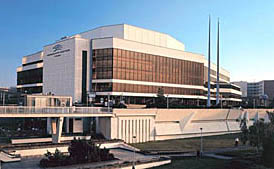
The Palace of Culture has been an unloved landmark of Prague for 30 years
 |
"Prague is getting... a cultural pavilion of such beauty and size that is rare in Europe and the whole world," said the head of Prague's communists, Antonín Kapek, at the opening. The period press also referred to it as a "symbol of socialist Prague." However, Prague residents took such statements with skepticism, and the building earned the unflattering nickname "Lidojem," or, at best, it was called "Pakul." On the other hand, 110,000 curious visitors didn't hesitate to wait in hour-long lines in mid-April 1981 to see the new addition to the Prague skyline from the inside.
From an architectural perspective, today's Congress Center is nothing special; experts say it is essentially a copy of a similar structure that was built in the mid-60s in West German Hamburg. This was also acknowledged by one of the palace's authors, Jaroslav Trávníček, who years ago stated that he and his colleagues deliberately adhered to proven methods. "It is not some great achievement of architecture, but don’t let anyone tell me it’s a bad concept," Trávníček defended his work.
The design from the Military Project Institute (VPÚ), on which the building was based, was originally not selected by the jury. The project from the Capital City of Prague's Project Institute was preferred initially. "But our victory was not anticipated, so another round of selections was organized," recalled the recently deceased architect Jan Bočan. "For us not to win, the chairman of the jury had to step down in the end," said the architect credited with the designs of embassies in London and Stockholm, among others.
The reasons for the influence of the competition at the time can likely be found in politics. "Soldiers were more acceptable to the party. It was automatically assumed that the creators of the Palace of Culture would receive the Klement Gottwald Award, and we weren’t even in the party. It was impossible at that time without that...," Bočan lamented. However, he also added that the forced continuation of the competition led to positive outcomes, as it prompted the authors from VPÚ to improve their design.
The building, for which the government decided on construction in February 1975, began to rise on the edge of the Nusle Valley in 1976 – thus completed in five years. However, the congresses of the Communist Party, for which it was mainly intended, ultimately only used the Palace of Culture twice, and after 1989, its further use was complicated. For several years, part of the palace (renamed in 1995 to the Prague Congress Center; KCP) housed the Prima TV channel, there was even a car dealership on the ground floor, and a musical adaptation of Dracula was performed in the main hall.
A significant impetus for the building eventually came from the meeting of the International Monetary Fund and the World Bank, which it hosted in September 2000, prior to which it underwent modernization. Two years later, the highest representatives of the North Atlantic Alliance also met in the premises designed for the Communist rulers of Czechoslovakia. However, the reconstruction at the end of the 90s, which cost three billion crowns, still burdens KCP's finances.
Despite the economic problems, the former Palace of Culture is not a dead building; it regularly hosts various congresses, and cultural performances are also held in its halls. The reconstructed Congress Hall can even compete with the best concert halls in the world. Nevertheless, there are still occasional calls for the demolition of the massive building, and three years ago, there was even a heated debate surrounding Kaplický's proposal for a new National Library building, during which the idea of converting the Congress Center into a library emerged instead.
The English translation is powered by AI tool. Switch to Czech to view the original text source.
0 comments
add comment
Related articles
0
28.03.2023 | The leadership of Prague wants to negotiate with the state about the future of the Prague Congress Center
0
31.03.2021 | The Congress Center Prague has towered over the Nusle Valley for 40 years
0
22.06.2018 | KCP increased revenue today, but is in loss due to building repairs
4
12.09.2017 | The winner of the construction of the new hall of the Prague Congress Center is the Spanish office OCA
0
07.09.2017 | New KCP - Announcement of the results of the architectural and urban planning competition
1
21.06.2017 | The Congress Center will select the winner of the construction completion competition at the beginning of July
0
14.12.2016 | The Congress Center Prague has announced a competition for the completion of the building
2
22.11.2016 | The congress center is preparing a competition for the completion of its building
0
06.05.2008 | The main authors of the Palace of Culture do not like the idea of a library
0
29.04.2008 | <Bém> Putting a library in the Congress Center is an interesting idea. </Bém>
0
28.04.2008 | Author Palace of Culture: The building needs a new function
1
30.03.2006 | <html>
<head>
<title>Palace of Culture Celebrates a Quarter Century Since Its Opening</title>
</head>
<body>
<p>The Palace of Culture is celebrating a quarter of a century since its opening.</p>
</body>
</html>












